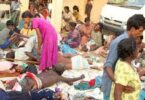Shoshana Bryen
While no one has seriously suggested the coronavirus was man-made or designed as a bioweapon, had that been the case it would have been a complete and utter failure.
The virus spread everywhere and hit China, Russia, the US, Britain and the other NATO countries. While it has made a mess, causing death and economic destruction, it has not greatly impact military forces. The US military actually fared far better than the overall population and is now seeing the first fall-off in virus cases. The total navy figure for Covid-19 infections is 1,298. The army reports 717 cases, the air force 317 and the marines 229.
No American active duty military person died, although one sailor died “of complications” of Covid-19. In addition, there are 36,750 National Guard members deployed in the United States, primarily in tasks that put them in direct contact with the worst of the worst infection hotspots. Not one activated National Guard member has died. The Pentagon’s Inspector General has announced an inquiry into how the navy handled the coronavirus outbreak.
In play are the question of highly risky port calls – the USS Theodore Roosevelt docked in Vietnam and the sailors were on the ground for five days in March – and the fact that ships were “quarantined” at sea for two weeks after port calls, even knowing that quarantining civilian cruise ship guests and staff together exacerbated the spread of the virus.
Carrier on board: The navy reportedly believes that the USS Roosevelt infections came mostly from carrier on board (“COB”) deliveries of supplies to the carrier after it left Da Nang. The COB flights originated in Vietnam, Japan and the Philippines.
The Arleigh Burke-class destroyer USS Kidd counted 64 cases after counter-drug operations in and around Central America. On the other hand, the USS Bunker Hill that visited Vietnam along with the USS Roosevelt did not have any coronavirus infections, reinforcing the possibility that the COB flights were the primary infection vector.
COB deliveries are by aircraft and helicopters. The Grumman C-2 Greyhound is a twin-engine, high-wing cargo aircraft, designed to carry supplies, mail and passengers to and from an aircraft carrier. The C-2 will be replaced starting this year by the V-22 Osprey. The V-22 is a tilt-rotor military aircraft with both vertical take-off and landing, and short take-off and landing capabilities. The National Guard units are organized by states and are tasked by governors, although they can be put under federal orders. The 36,750 deployed Guard personnel provide an interesting study.
In Pennsylvania’s Lehigh Valley, about 45 miles from Philadelphia, the Guard was sent in to help the Gracedale Nursing Home in Upper Nazareth Township. Gracedale is a high-rise facility with more than 600 residents and a regular staff of 700, although at least half of them were not showing up for work. Before the National Guard was called in, there were 135 residents infected and 39 who died in this one home. Guard personnel worked eight to 12-hour shifts in the nursing home, providing medication, delivering food, making beds and other duties.
On the front line: Across the United States, National Guard duties have included entering nursing homes to test patients and staff, working drive-through testing sites, collecting the dead and sometimes assisting in burials or cremations, and helping in the production of Personal Protective Equipment (PPE).
Though the overall National Guard numbers of infected personnel are higher than for the regular army, the number of infections overall is hovering around 1.8%, close to the national infection rate of about 2%. Unlike much of the population living in lockdown conditions, the National Guard is directly engaged with disease victims, more than any of the other military services, and roughly on the level of healthcare workers.
All US statistics, as those in other countries, are subject to adjustment because testing rates are still low and test results have a built-in error rate, typically false negatives. In fact, the military services are having trouble identifying cases because at least half of those who are tested positive are asymptomatic. The mortality rate in the military is near zero, while the mortality rate among infected persons in the general American population is about 4%.
But these statistics are deceptive because most of the military infections are among people under 40, and more than half of the civilian infections are for those over 60, and often the deaths are complicated by pre-existing conditions.
Medical personnel: If the mortality rates were adjusted by age, it would also be extremely low statistically for the two-thirds of the public under age 60. As noted above, no deployed National Guard personnel have died, but the situation for healthcare and social workers is rather worse. The Center for Evidence-Based Medicine reported: “Healthcare workers … had a higher risk of exposure and became vectors of onward transmission.”
Chinese numbers on coronavirus cases are suspect, but China reports more than 3,300 healthcare workers infected – 4% of the 81,285 total reported infections. In Spain on March 25, nearly 6,500 medical personnel accounted for 13.6% of the country’s 47,600 total cases.
Italy reported 2,609 healthcare workers infected. In the UK, there were 106 deaths among healthcare and social care workers. The US numbers are still too fragmentary to report with confidence.
What we see is that, overall, the coronavirus has had little effect on the US military, notwithstanding the numbers on the USS Roosevelt and USS Kidd that still have to be better understood. The virus certainly massively damaged the US economy, but it has not impacted much of the rest of the critical infrastructure beyond transportation and healthcare.
For the most part, the US has recovered its healthcare capabilities as coronavirus cases drop off. Transportation remains an issue that will probably only recover when people go back to work and the borders reopen. If there is an overall lesson, it is that the coronavirus was not a good bio-weapon candidate. Its military impact was negligible and the damage recoverable – except for the deaths, of course). Moreover, the military has learned ways to cope with a pandemic, giving it a head start on any future outbreak.






